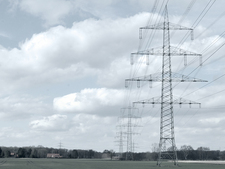-
Topics
subnavigation
Topics
Electromagnetic fields
- What are electromagnetic fields?
- Static and low-frequency fields
- Radiation protection relating to the expansion of the national grid
- Basics transfer of electrical power
- Effects
- Established effects
- Discussed effects of low-frequency fields
- Further environmental effects
- Protection
- High-frequency fields
- Radiation protection in mobile communication
Optical radiation
Ionising radiation
- What is ionising radiation?
- Radioactivity in the environment
- Applications in medicine
- Applications in daily life and in technology
- Effects
- What are the effects of radiation?
- Effects of selected radioactive materials
- Consequences of a radiation accident
- Cancer and leukaemia
- Genetic radiation effects
- Individual radiosensitivity
- Epidemiology of radiation-induced diseases
- Ionising radiation: positive effects?
- Risk estimation and assessment
- Radiation protection
- Nuclear accident management
- Service offers
-
The BfS
subnavigation
The BfS
- About us
- Science and research
- Laws and regulations
- BfS Topics in the Bundestag
- Links
Further impacts of low-frequency fields on the environment
In the debate on grid expansion and high-voltage power lines, the discharge effects in the immediate vicinity of the lines ("corona effects") and their impact on animals and plants are of major relevance.
Corona effects
The term "corona" (crown) refers to the effect range of the discharge in close proximity to the live parts of a high-voltage pylon. These discharges can generate noise, which is especially pronounced during certain weather conditions such as fog, rain or snow. What is usually heard is a crackling often together with a constant buzzing sound. This noise may be perceived as annoying.
Furthermore, small amounts of ozone and nitrogen oxides can be formed in the corona of high-voltage overhead lines. However, at a distance of a few metres from the lines their amounts are barely detectable.
In addition, air components can become charged positively or negatively by the corona. These "corona ions" can attach to pollutants in the air and change their charge state. English scientists assume that this charging enhances the uptake of these particles into the body which might contribute to the development of diseases due to air pollution. As the charged particles would enter the body through the lungs, especially respiratory diseases and lung cancer would come to mind here. However, there is no scientific evidence for this assumption. The British radiation protection authority NRPB has addressed this question. An additionally increased health risk from air pollutants due to charged particles around conventional high-voltage lines is considered unlikely or very low. At direct current lines, larger amounts of particles might become charged that also might expand further. Therefore, more research is needed.
Animals and plants
According to current scientific knowledge, animals and plants are not harmed by the electric and magnetic fields of high-voltage power lines. However, direct effects of electricity such as electric shocks are possible. Species of animals which sense the Earth’s magnetic field and orient themselves accordingly may experience behavioural changes in close proximity to high-voltage power lines.

![]() Offshore wind farm south of the Danish island of Samsö
Source: Prof. Dr. Horst Crome
Offshore wind farm south of the Danish island of Samsö
Source: Prof. Dr. Horst Crome
Cables in the seabed which are used to transmit power from offshore wind farms to land constitute a special case (offshore cables). According to current knowledge, their electric and magnetic fields have no detrimental impact on marine organisms. However, they may possibly influence the behaviour of certain species of animals.
Some fish, sharks in particular, are able to detect very weak fields such as the Earth's magnetic field and to use these to orient themselves. These fish can also perceive the fields generated by power cables and might change their behaviour accordingly. Sharks use very weak fields when searching for prey but also quickly learn to ignore fields which do not indicate prey. Stronger fields can irritate some species of fish and may slow them down while passing over the cables. However, they do not have a complete barrier effect. Whether the changes in behaviour described above have an impact on the ecosystem is still being researched. Which effect the heat emanating from the cables has on the organisms in the seabed in close proximity to the cables is also being investigated.
State of 2018.02.19



